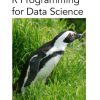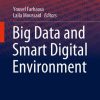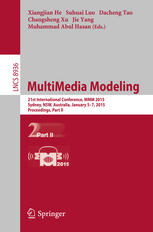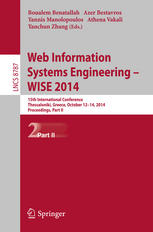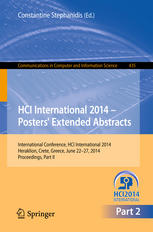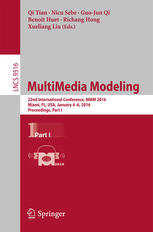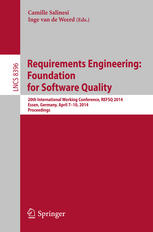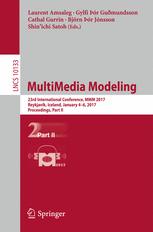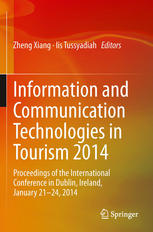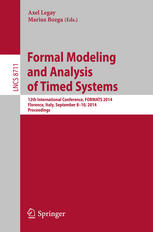MultiMedia Modeling 20th Anniversary International Conference MMM 2014 Dublin Ireland January 6 10 2014 Proceedings Part II 1st Edition by Sema Alaçam 3319041179 9783319041179
$50.00 Original price was: $50.00.$25.00Current price is: $25.00.
MultiMedia Modeling 20th Anniversary International Conference MMM 2014 Dublin Ireland January 6 10 2014 Proceedings Part II 1st Edition by Sema Alaçam – Ebook PDF Instant Download/DeliveryISBN: 3319041179, 9783319041179
Full download MultiMedia Modeling 20th Anniversary International Conference MMM 2014 Dublin Ireland January 6 10 2014 Proceedings Part II 1st Edition after payment.
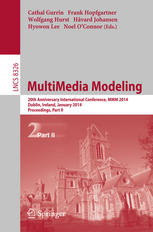
Product details:
ISBN-10 : 3319041179
ISBN-13 : 9783319041179
Author: Sema Alaçam
The two-volume set LNCS 8325 and 8326 constitutes the thoroughly refereed proceedings of the 20th Anniversary International Conference on Multimedia Modeling, MMM 2014, held in Dublin, Ireland, in January 2014. The 46 revised regular papers, 11 short papers, and 9 demonstration papers were carefully reviewed and selected from 176 submissions. 28 special session papers and 6 papers from Video Browser Showdown workshop are also included in the proceedings. The papers included in these two volumes cover a diverse range of topics including: applications of multimedia modelling, interactive retrieval, image and video collections, 3D and augmented reality, temporal analysis of multimedia content, compression and streaming. Special session papers cover the following topics: Mediadrom: artful post-TV scenarios, MM analysis for surveillance video and security applications, 3D multimedia computing and modeling, social geo-media analytics and retrieval, multimedia hyperlinking and retrieval.
MultiMedia Modeling 20th Anniversary International Conference MMM 2014 Dublin Ireland January 6 10 2014 Proceedings Part II 1st Table of contents:
1 Introduction
2 Related Tangible Work
3 Sources of (Dis)content
4 Scenarios
4.1 Subplot 1 – Tweets around Gezi Park
4.2 Subplot 2 –Changing Façade of Atatürk Cultural Center (AKM)
4.3 Subplot 3 – Street Art around Gezi Park
5 Experiment Setup
6 Evaluation of Possible Complementary Technologies
6.1 Data Collection and Hypermedia Linking
6.2 Content-Based Analysis
7 Discussion and Future Work
References
Scenarizing Metropolitan Views: FlanoGraphing the Urban Spaces
1 Introduction
2 Background
3 The FlanoGraph: Use Cases
3.1 Description
3.2 Use Cases
4 Analysis of Technologies
4.1 Intelligent Hypervideo Analysis
4.2 Linking Hypervideo to Web Content
4.3 Interfaces and Presentation Engines
4.4 Contextualisation and Personalisation
5 Sources of Web and Media Content and Their Related Copyright/Copyleft Issues
6 Conclusion
References
Scenarizing CADastre Exquisse: A Crossover between Snoezeling in Hospitals/Domes, and Authoring/Exp
1 Introduction and Context
1.1 Anatomy of Comic Strips
1.2 Augmenting Image with Sound
1.3 Snoezelen and Immersive/Participatory Environments
2 Scenarios of CADastre Exquisse
2.1 Snoezeling in the Dome
2.2 Snoezeling in Hospitals
3 New Technologies Extending Comic Strips and Allowing Immersive and Participatory Environments
3.1 Intelligent Comic Strip Analysis
3.2 Hypercomics and Web Content Copylefts
3.3 Interfaces and Presentation Engines
3.4 Contextualisation and Personalisation
4 Conclusion and Future Work
References
An Interactive Device for Exploring Thematically Sorted Artworks
1 Introduction, Artistic Intention
2 Context, Similar Works
3 Description of the Scenario
3.1 Context and Setup
3.2 Interactive Content Exploration
4 Analysis of Technologies That Would Help to Realize the Scenario
4.1 Interfaces and Presentation Engines
4.2 Intelligent Hypervideo Analysis
4.3 Linking Hypervideo to Web Content
4.4 Contextualisation and Personalisation
5 Sources of Web and Media Content and Their Related Copyright/Copyleft Issues
6 Conclusion
References
Special Session: MM Analysis for Surveillance Videoand Security Applications
Hierarchical Audio-Visual Surveillance for Passenger Elevators
1 Introduction
2 Related Work
3 System Configuration
4 The Proposed Framework
5 Audio Analysis
5.1 Event Detector
5.2 Event Classifier
6 Visual Analysis
6.1 Passenger Counting
6.2 Passengers Interaction
6.3 Liquid Patch Detection
6.4 Aggression Detection
7 Experimental Results
8 Conclusion
References
An Evaluation of Local Action Descriptors for Human Action Classificationin the Presence of Occlusi
1 Introduction
2 Local Action Descriptors
2.1 Trajectory Descriptor (TRAJ)
2.2 The HOG/HOF Descriptor
2.3 The Motion Boundary Histogram (MBH) Descriptor
3 Experimental Setup
3.1 Dataset
3.2 Synthetic Occlusion
3.3 Evaluation Framework
3.4 Classification
4 Experimental Results
5 Discussion
6 Conclusion and Future Work
References
Online Identification of Primary Social Groups
1 Introduction
2 Related Work
3 Proposed Methodology
3.1 Group Identification Criteria
3.2 Prediction of Trajectory Evolution
3.3 Online Group Identification
4 Experimental Results
4.1 Dataset
4.2 Group Identification Results
5 Conclusions and Discussion
References
Gait Based Gender Recognition Using Sparse Spatio Temporal Features
1 Introduction
2 System Description
2.1 Dataset
2.2 Feature Descriptors
3 Experiments and Results
3.1 Experiment 1 Clip Length
3.2 Experiment 2 Temporal Pooling and Number of Cuboids Extracted Per Clip
4 Conclusion
References
Perspective Multiscale Detection and Tracking of Persons
1 Introduction
2 Approach Overview
3 Perspective Multiscale Detection
3.1 Perspective Multiscale
3.2 Ground Plane Calibration
3.3 Model Reprojection
4 Detection
5 Tracking
5.1 Rao-Blackellized Data Association Particle Filter
5.2 Data Association Filter
6 System Test and Discussion
7 Conclusions
References
Human Action Recognition in Video via Fused Optical Flow and Moment Features – Towards a Hierarchi
1 Introduction
2 Related Work
3 Methodology
3.1 HOOF Features
3.2 2D Zernike Moments of Efros Optical Flow Channels
4 Experimental Results
4.1 Comparison of Feature Parameter Settings
4.2 Comparison of HOOF and Fused Features
4.3 Effect of Additive Noise
5 Conclusions
References
Special Session: 3D Multimedia Computing and Modeling
Sparse Patch Coding for 3D Model Retrieval
1 Introduction
2 Low-Level Semantic Patch
3 PatchDescription
4 High-Level Patch Coding
4.1 Sparse Coding
4.2 Algorithm
5 Experiments
5.1 Data Set and Measures
5.2 Comparative Methods
5.3 Numerical Results
6 Conclusion
References
3D Object Classification Using Deep Belief Networks
1 Introduction
2 Related Work
2.1 Model Descriptors
2.2 Semantic Understanding
3 Deep Learning Based Classification Model
3.1 Extracting Feature Using Deep Belief Networks
3.2 Semi-supervised Algorithm for 3D Model Recognition
3.3 Classification
4 Experiment Setups
4.1 Model Database and Evaluation Measurement
4.2 Compared Methods
5 Experimental Results
6 Conclusion
References
Pursuing Detector Efficiency for Simple Scene Pedestrian Detection
1 Introduction
2 Bottleneck of Fast Pedestrian Detector
3 ProposedMethod
3.1 Structured Local Edge Pattern
3.2 Fast Classifier Score Prediction Based on Integral Images
4 Experiment Results
4.1 Dataset and Performance Measurements
4.2 Detection Speed
4.3 Detection Accuracy
5 Conclusions and Future Work
References
Multi-view Action Synchronization in Complex Background
1 Introduction
2 Related Works
3 Action Synchronization Framework
3.1 Feature for Meta-action
3.2 Self-similarityMeasurement
3.3 Action Synchronization
4 Experiments
4.1 The Same Perspective Sequence
4.2 The Different Perspective Sequence
5 Conclusion
References
Parameter-Free Inter-view Depth Propagation for Mobile Free-View Video*
1 Introduction
2 Parameter-Free Depth Interview Propagation
2.1 Depth Estimation for Each View
2.2 Inter-view Relationship Generation
2.3 Inter-view Depth Propagation
3 Mobile Free-View Video Application Based on Depth Inter-view Propagation
4 Experiments and Discussions
5 Conclusions
References
Coverage Field Analysis to the Quality of Light Field Rendering
1 Introduction
2 Analysis for Coverage Field and Rendering Quality
2.1 The Definition of Coverage Field
2.2 Derivation of the Coverage Field Area
2.3 Derivation of the Rendering Quality
2.4 The Quantification of Rendering Quality
3 Optimization of Camera Position by Coverage Field
4 Experimental Results and Discussions
4.1 Simulation of the Coverage Field Area and the Rendering Quality
4.2 Synthetic Experimental Results and Discussions
4.3 Optimization Experimental Results
5 Conclusions
References
Special Session: Social Geo-Media Analytics and Retrieval
Personalized Recommendation by Exploring Social Users’ Behaviors
1 Introduction
2 Related Work
3 The Approach
3.1 Interpersonal Interest Similarity
3.2 Interpersonal Rating behaviors Similarity
3.3 Personalized Recommendation Model
3.4 Model Training
4 Experiments
4.1 Yelp Dataset
4.2 Performance Measures
4.3 Results and Discussion
5 Conclusions
References
Where Is the News Breaking? Towards a Location-Based Event Detection Framework for Journalists
1 Introduction
2 Related Work
3 A Framework for Location-Based Event Detection from UGC
4 Impact and Conclusions
References
Location-Aware Music Artist Recommendation
1 Introduction
2 Related Work
3 Data Acquisition
4 Data Representation
5 Music Recommendation Models
5.1 Experimental Setup
5.2 Results
6 Conclusions and Outlook
References
Task-Driven Image Retrieval Using Geographic Information
1 Introduction
2 Related Work
2.1 High-Level Image Representation
2.2 Geo-tagged Image Retrieval
3 Three Types of Image Retrieval Tasks
4 The Proposed Method
4.1 Semantic City Similarity Measurement
4.2 High-Level Image Representation Method
5 Algorithm Evaluation and Experimental Results
5.1 Data Preparation
5.2 Experiments on Semantic City Similarity
5.3 The Proposed Image Retrieval System
6 Conclusion
References
The Evolution of Research on Multimedia Travel Guide Search and Recommender Systems
1 Introduction
2 Overview
3 Query Analysis
4 Diversification
5 Ranking and Reranking
6 Personalization
7 Performance Evaluation
8 Conclusion and Future Research Directions
References
Special Session: Multimedia Hyperlinking and Retrieval
Average Precision: Good Guide or False Friend to Multimedia Search Effectiveness?
1 Introduction
2 Background and Related Work
3 Determining Research Agendas
3.1 Aspect Definition
3.2 Criteria to Analyze Research Agendas
4 Experiments
4.1 Data Sets and Measures
4.2 Influence of Selected Judges
4.3 Diversity Assessment
5 Discussion
6 Conclusions
References
An Investigation into Feature Effectiveness for Multimedia Hyperlinking
1 Introduction
2 Related Work
3 Experimental Design
3.1 Data Description
3.2 Linking Algorithm
4 Experimental Investigation
4.1 Crowdsourcing Task Design
4.2 Evaluation Overview
4.3 Evaluation Results and Analysis
5 Conclusions and Future Work
References
Mining the Web for Multimedia-Based Enriching
1 Introduction
2 Related Work
3 Framework
3.1 Time Segment Extraction
3.2 Video Focused Search
3.3 Candidate Set Filtering
4 Experiments
4.1 Popular Event Extraction
4.2 Evaluation Dataset
4.3 Candidate Set Filtering
5 Conclusion
References
Short Papers
Spatial Similarity Measure of Visual Phrases for Image Retrieval
1 Introduction
2 Algorithm
2.1 VP Model
2.2 Image-Specific VP Selection Strategy
2.3 Spatial Similarity Measure (SSM)
3 Experiments
3.1 Influence of Parameter K
3.2 Comparison of Retrieval Performances
4 Conclusion
References
Semantic Based Background Music Recommendation for Home Videos
1 Introduction
2 Music Selection Based on Textual Semantics
2.1 Textual Semantics in Video
2.2 Textual Semantics in Music
2.3 Textual Semantics Matching
3 Content Semantics Matching
3.1 Video Representation
3.2 Music Audio Representation
3.3 Content Matching
4 Evaluation
5 Conclusions and Future Works
References
Smoke Detection Based on a Semi-supervisedClustering Model
1 Introduction
2 Dataset and Features
2.1 Dataset
2.2 Features
3 Methodology
3.1 The Basic Semi-supervised Clustering Model
3.2 The Weighted Semi-supervised Clustering Model
4 Performance Study
4.1 The Number of Clusters
4.2 The First N Frames and the Threshold α
5 Experimental Result
6 Conclusion
References
Empirical Exploration of Extreme SVM-RBF Parameter Values for Visual Object Classification
1 Introduction
2 Related Works
3 Experiments
4 Discussion and Future Work
References
Real-World Event Detection Using Flickr Images
1 Introduction
2 Two-Step Event Detection
2.1 Preprocessing
2.2 Event Class Detection
2.3 Event Detection
3 Evaluation
4 Conclusions
References
Spectral Classification of 3D Articulated Shapes
1 Introduction
2 The Proposed Method
2.1 Feature Extraction
2.2 Feature Distance
2.3 Classification
3 Experiments
4 Conclusion
References
Improving Scene Detection Algorithms Using New Similarity Measures
1 Introduction
2 Related Work
3 Scene Detection
4 Evaluation
5 Conclusion and Future Work
References
EvoTunes: Crowdsourcing-Based Music Recommendation
1 Introduction
2 Proposed System m
2.1 Service Platform
2.2 Selecting Music r for Experiment
2.3 Gathering Experim mental Data
2.4 Updating Probabilities of Transition
2.5 Data Validation
3 Results
3.1 Transition Probabilities
3.2 User Satisfaction
4 Conclusion
References
Affect Recognition Using Magnitude Models of Motion
1 Introduction
2 Related Work
3 Approach Description
4 Experiments and Results
5 Conclusion
References
Effects of Audio Compression on Chord Recognition
1 Introduction
2 Evaluation of Effects of Audio Compression
2.1 Chroma Vector Calculation
2.2 Perceptual Evaluation of Audio Quality (PEAQ)
2.3 Application to Chord Recognition
3 Experimental Results
3.1 PEAQ Evaluation
3.2 Chord Recognition Performance
4 Discussions
5 Implementation
6 Conclusions
References
The Perceptual Characteristics of 3D Orientation
1 Introduction
2 Experimental Device Design
3 Experiment Method
4 Experiment Results
5 Conclusion
References
Demonstrations
Folkioneer: Efficient Browsing of Community Geotagged Images on a Worldwide Scale
1 Introduction
2 Folkioneer Architecture
3 Demonstration Details
4 Conclusion
References
Muithu: A Touch-Based Annotation Interface for Activity Logging in the Norwegian Premier League
1 Introduction and Description
2 Evaluation
3 Discussions and Conclusions
References
FoodCam: A Real-Time Mobile Food Recognition System Employing Fisher Vector
1 Introduction
2 System Overview
3 Implementation and Evaluation
References
The LIRE Request Handler: A Solr Plug-In for Large Scale Content Based Image Retrieval
1 Introduction
2 Implementation
3 Demo Application
4 Conclusion
References
M3 + P3 + O3 = Multi-D Photo Browsing
1 Introduction
2 TheM3 Data Model
3 TheP3 Prototype Photo Browser
4 TheO3 Prototype Media Server
5 Demonstration Scenarios
References
Tools for User Interaction in Immersive Environments
1 The REVERIE Project
2 Use Cases
3 Proposed Demonstrations
3.1 Navigable 3D Videochat
3.2 Gaze Translucency
3.3 Real-Time Full Body 3D Reconstruction
3.4 RAAT: The REVERIE Avatar Authoring Tool
3.5 Puppeting the Gaze of a Virtual Avatar
3.6 Real-Time Head Nod and Shake Detection
3.7 Window to Virtual Worlds
4 Conclusion
RESIC: A Tool for Music Stretching Resistance Estimation
1 Introduction
2 System Overview
3 Demonstration
References
A Visual Information Retrieval System for Radiology Reports and the Medical Literature
1 Introduction
2 Clinical Radiology 3D Image Search
3 2D Medical Document Image Search
4 Conclusions
References
Eolas: Video Retrieval Application for Helping Tourists
1 Introduction
2 System Overview
3 System Implementation and Performance Evaluation
3.1 Offline Video Processing Pipeline
3.2 Exemplar-SVM Based Scoring Scheme
3.3 Performance Evaluation
4 Conclusion
References
Video Browser Showdown
Audio-Visual Classification Video Browser
1 Introduction
2 System Features
2.1 Video Segmentation
2.2 Visual Concept Classification
2.3 Audio Concept Classification
2.4 Visual Similarity Search
2.5 Face Browsing and Search
3 UserInterface
4 Conclusion
References
Content-Based Video Browsing with Collaborating Mobile Clients
1 Introduction
2 System Architecture
2.1 Server
2.2 Mobile Clients
3 Conclusion
References
Browsing Linked Video Collections for Media Production
1 Introduction
2 BrowsingUserInterface
References
VERGE: An Interactive Search Engine for Browsing Video Collections
1 Introduction
2 Video Retrieval System
3 Interaction Modes
References
Signature-Based Video Browser
1 Introduction
2 Signature-Based Video Browser
3 Conclusions
References
NII-UIT: A Tool for Known Item Search by Sequential Pattern Filtering
1 Introduction
2 System Overview
2.1 Preprocessing
2.2 Indexing and Retrieval
2.3 User Interface
People also search for MultiMedia Modeling 20th Anniversary International Conference MMM 2014 Dublin Ireland January 6 10 2014 Proceedings Part II 1st:
international conference on multimedia modeling
international conference on multimedia modeling 2025
international conference on multimedia modeling ranking
international conference on multimedia modeling ccf
international conference on multimedia modeling acceptance rate
Tags: MultiMedia Modeling, Anniversary International, Dublin Ireland, Proceedings, Sema Alaçam
You may also like…
Computers - Computer Science
Computers - Computer Science
Computers - Computer Science
Computers - Programming
Science (General) - International Conferences and Symposiums
Business & Economics
Computers - Computer Science


